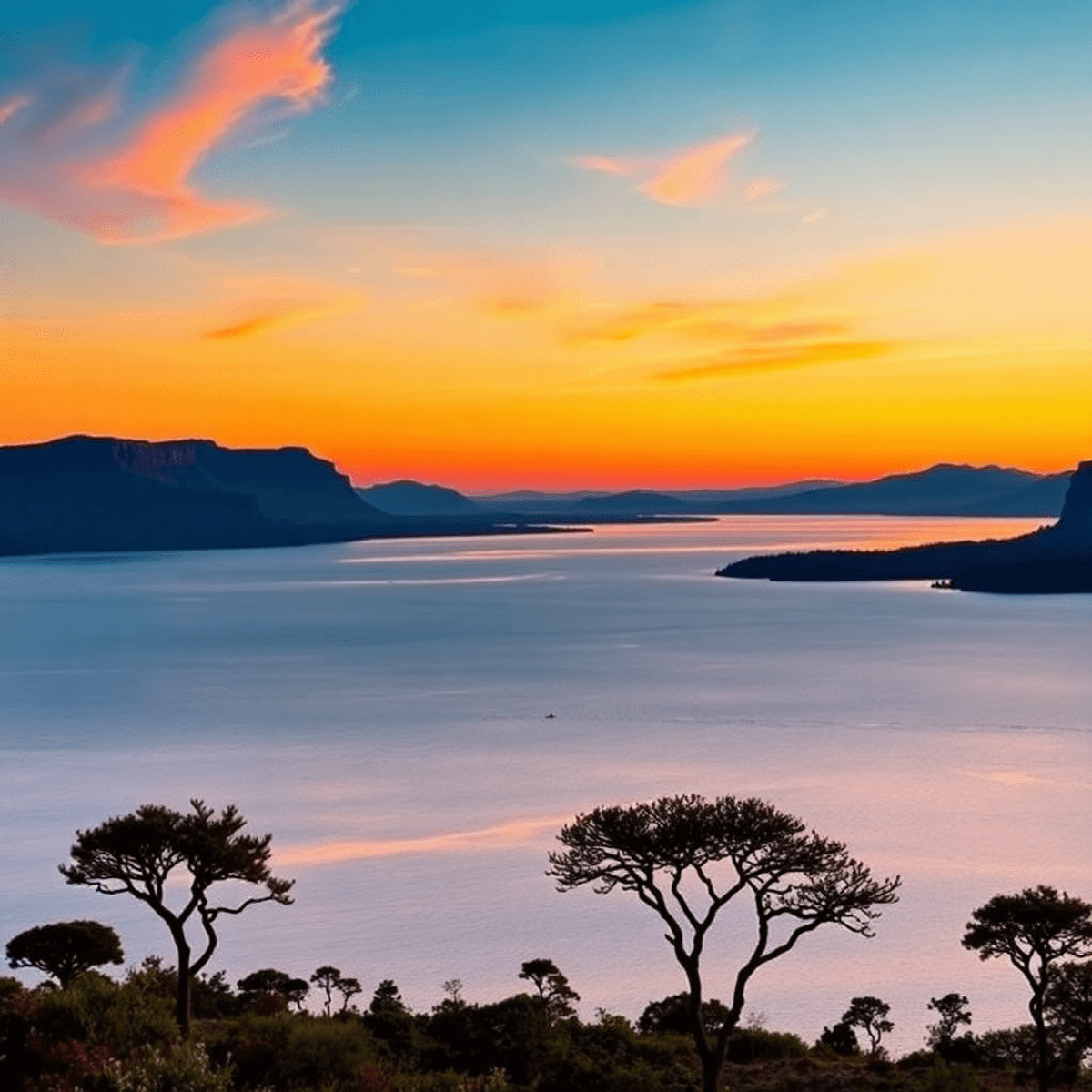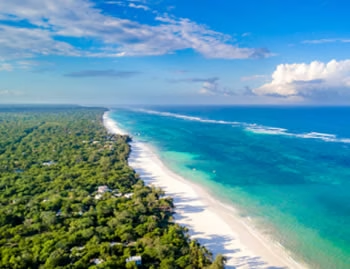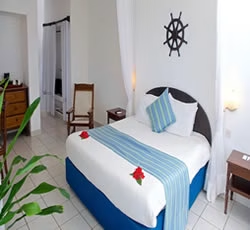10 reasons to visit Naivasha's Attractions

A stunning sunset over Lake Naivasha, with vibrant orange and pink reflections on the water, silhouetted acacia trees, and dramatic cliffs in the background.
10 Reasons to Visit Naivasha's Attractions
Nestled in Kenya's Great Rift Valley, Lake Naivasha stands as a natural wonder that captivates visitors with its pristine beauty and diverse ecosystem. This freshwater lake spans 140 square kilometers, creating a haven for wildlife enthusiasts, adventure seekers, and nature lovers alike.
The region's attractions extend beyond the lake itself. From the rugged landscapes of Hell's Gate National Park to the serene Oserengoni Conservancy, Naivasha offers experiences that leave lasting memories. Whether you're watching hippos splash in the crystal-clear waters or spotting rare bird species along the shoreline, each moment brings new discoveries.
Ready to explore this enchanting destination? Here are 10 compelling reasons that make Naivasha a must-visit destination for your next adventure.
1. Stunning Natural Beauty at Lake Naivasha National Park
Lake Naivasha National Park's 140 square kilometers showcase nature's masterpiece within the Great Rift Valley. Dramatic cliffs rise from crystal-clear waters, creating a striking contrast against the African sky. Ancient volcanic formations dot the landscape, telling tales of the region's turbulent geological past.
The Great Rift Valley's tectonic activity has sculpted this region into a photographer's paradise. You'll find sweeping vistas of acacia-dotted savannas meeting pristine shorelines, creating perfect photo opportunities at every turn.
Photography Tips for Stunning Shots:
- Visit during golden hour (sunrise/sunset) for dramatic lighting
- Position yourself at Baboon Cliff viewpoint for panoramic shots
- Use wide-angle lenses to capture the expansive landscapes
- Include acacia trees in your frame for authentic African scenery
- Shoot during the dry season for clear, dust-free skies
The park's unique topography creates distinct microclimates, supporting diverse ecosystems from wetlands to woodlands - each offering its own photographic charm.
2. Diverse Wildlife Encounters in Naivasha
Lake Naivasha is home to an incredible variety of wildlife, making it a paradise for nature lovers. Here, you can expect to see around 1,500 hippos relaxing in the water, creating ripples across the lake's surface. The area is also rich in wildlife, with:
- Graceful giraffes feeding on acacia trees
- Zebras munching on the grassy shores
- Waterbucks and impalas swiftly moving through the bushes
- 400+ bird species such as:
- Pink flamingos
- Fish eagles
- Kingfishers
- African spoonbills
The lake offers unique opportunities to observe wildlife through guided boat tours. These tours allow you to get up close to hippo pods while maintaining a safe distance, witness fish eagles diving for their meals, or participate in specialized birdwatching trips led by knowledgeable guides. The best times for spotting animals are during early morning and late afternoon tours when they are most active.
3. Adventure Activities for Nature Lovers in Naivasha
Naivasha's diverse landscape creates a natural playground for outdoor enthusiasts. The towering Mount Longonot presents a challenging 2-4 hour hike through its steep slopes and rocky terrain. You'll find well-marked trails leading to the crater rim, offering panoramic views of the Great Rift Valley.
Hiking at Mount Longonot
The highlight of any trip to Naivasha is undoubtedly a hike up Mount Longonot. This dormant volcano stands tall at 2,776 meters and offers an exhilarating trekking experience for adventure seekers.
Here's what you need to know about hiking at Mount Longonot:
- Duration: The hike typically takes between 2 to 4 hours, depending on your fitness level and pace.
- Difficulty Level: Expect steep slopes and rocky terrain throughout the trek. It's recommended for those with moderate fitness levels.
- Trail Information: The trails are well-marked, making it easy to navigate even without a guide.
- Viewpoints: As you ascend, be prepared to be rewarded with breathtaking views of the surrounding landscape, including Lake Naivasha and the Great Rift Valley.
Biking Adventures Along the Lakeshores
If you're looking for a different kind of adventure, biking along the lakeshores is an excellent option. Naivasha offers flat terrains that are perfect for leisurely rides, making it suitable for beginners as well.
Here's how you can make the most of your biking experience in Naivasha:
- Rent Quality Mountain Bikes: There are several local vendors who offer bike rentals with safety equipment. This ensures that you have a comfortable and safe ride during your exploration.
- Explore Hell's Gate National Park: For more experienced cyclists seeking a challenge, consider venturing into Hell's Gate National Park. Here, you'll find rugged paths that will test your biking skills while allowing you to immerse yourself in nature.
- Combine Hiking and Biking: If time permits, why not combine both activities? Some local tour operators offer packages that include hiking at Mount Longonot followed by biking along the lakeshores or vice versa.
Guided Tour Options
For those who prefer guided experiences or want assistance with logistics, here are some options available:
- Professional hiking guides for Mount Longonot ($30-50 per group)
- Bike rentals with safety equipment ($15-25 per day)
- Combined hiking-biking packages available from local tour operators
Self-Guided Exploration
If you're an independent explorer or simply enjoy setting your own itinerary, fret not! Naivasha also offers self-guided options:
- Clearly Marked Trails: Most trails within the area are clearly marked, making it easier for you to navigate without getting lost.
- Detailed Maps at Park Entrances: Before heading out on your adventure, make sure to grab a detailed map from any park entrance. This will help you plan your route effectively.
Best Time for Hiking
To make the most out of your hiking experience in Naivasha:
- Aim to start early in the morning when temperatures remain cool.
- Early mornings also tend to have higher wildlife activity levels which can add an extra thrill to your trek!
With these tips in mind, gear up for an unforgettable adventure amidst nature's wonders in beautiful Naivasha!
4. Exploring Crescent Island Wildlife Sanctuary
Crescent Island offers a unique walking safari experience where you can get remarkably close to the wildlife. Your adventure begins with a scenic boat ride across Lake Naivasha to reach this horseshoe-shaped paradise.
The sanctuary hosts an impressive array of animals living freely in their natural habitat:
- Towering Rothschild giraffes grazing on acacia trees
- Graceful Grant's and Thomson's gazelles
- Zebras roaming in small herds
- Waterbucks lounging near the shoreline
- Countless bird species nesting in the trees
"Walking among giraffes without fences or vehicles between us was surreal. The animals are so accustomed to visitors that you can observe their natural behaviors up close," shares wildlife photographer Sarah Chen.
The absence of predators makes Crescent Island safe for walking tours. You can choose between guided walks with knowledgeable local experts or explore the well-marked trails at your own pace. The elevated viewpoints provide spectacular photo opportunities of both the wildlife and Lake Naivasha's shimmering waters.
5. Serenity at Crater Lake Game Sanctuary
Crater Lake Game Sanctuary offers a hidden gem of tranquility away from Lake Naivasha's popular tourist spots. The sanctuary's pristine waters reflect the surrounding cliffs, creating a mirror-like surface that captivates visitors seeking peaceful moments in nature.
You'll discover a rich tapestry of wildlife within this secluded haven:
- Resident Zebras graze peacefully along the crater's rim
- Elusive Leopards occasionally spotted during dawn and dusk
- 150+ Bird Species call this sanctuary home
The sanctuary's volcanic crater formation provides a natural amphitheater effect, amplifying the sounds of nature while blocking out external noise. Walking trails wind through acacia woodlands, offering intimate wildlife viewing opportunities without the crowds found at larger parks.
A dedicated bird hide near the lake's edge lets you observe waterfowl in their natural habitat, making this spot particularly appealing for wildlife photographers and nature enthusiasts seeking authentic encounters.
6. Thrilling Adventures at Hell's Gate National Park
Hell's Gate National Park sits just 14 kilometers from Lake Naivasha, making it a perfect destination for adventurous day trips. You'll discover dramatic cliffs, towering rock formations, and steaming geothermal vents that create an otherworldly landscape.
The park offers two main adventure activities:
- Hiking through gorges: Navigate the narrow corridors of Ol Njorowa Gorge, where skilled guides share stories about the area's geological history. The steep walls rise dramatically on both sides, creating an immersive canyon experience.
- Cycling adventures: Rent a bike at the park entrance to explore 25 kilometers of well-maintained trails. You'll pedal past grazing zebras, gazelles, and buffaloes while taking in panoramic views of Fischer's Tower and other distinctive rock formations.
The park's unique terrain allows you to get remarkably close to wildlife - imagine cycling past a tower of giraffes or spotting a family of warthogs from your bike seat.
7. Relax and Rejuvenate at Mvuke Spa in Naivasha
After all the excitement, Mvuke Spa is the perfect place to relax and recharge. This wellness retreat offers a combination of traditional and modern treatments that are designed to refresh both your body and mind.
Signature Treatments
The spa's signature treatments include:
- Deep tissue massages using locally sourced essential oils
- Hot stone therapy with volcanic rocks from the Rift Valley
- Aromatherapy sessions featuring indigenous African botanicals
- Therapeutic mud wraps enriched with mineral-rich clay
Tranquil Atmosphere
You'll find the spa surrounded by beautiful gardens, creating a peaceful environment that enhances your wellness experience. The treatment rooms have large windows that offer breathtaking views of Lake Naivasha, allowing you to connect with nature during your session.
Personalized Care
The skilled therapists at Mvuke Spa tailor each treatment to meet your individual needs, ensuring a customized experience that helps you relax and recharge for your upcoming adventures in Naivasha.
8. Educational Visit to Elsamere Conservation Center
Elsamere Conservation Center is a shining example of Kenya's commitment to wildlife preservation. Here, you'll find engaging educational programs that highlight the region's conservation efforts through interactive sessions and hands-on learning experiences.
What You Can Expect at Elsamere
The center offers a range of activities designed to educate visitors about local wildlife and conservation initiatives:
- Daily Conservation Talks: Learn about local wildlife protection initiatives
- Bird Watching Sessions: Identify and study various bird species in their natural habitat
- Nature Trail Walks: Explore guided paths while learning about indigenous plants
- Wildlife Documentary Screenings: Watch informative films about local conservation
Get Up Close with Wildlife
One of the highlights of visiting Elsamere is the opportunity to go on guided nature walks. Accompanied by expert guides, you'll have the chance to observe animals in their natural environment and gain valuable insights into their behavior, as well as the importance of preserving ecosystems.
Discover Ongoing Research Projects
As you explore the center, don't miss out on the interactive exhibits showcasing their ongoing research projects. These displays offer a unique perspective on wildlife conservation efforts in the Lake Naivasha region, providing practical examples of how such initiatives are implemented.
Relax in the Tea Garden
After an enriching day of learning and exploration, take some time to unwind at the center's tea garden. Here, you can enjoy a cup of tea while watching colobus monkeys playfully swinging through the trees—a delightful way to connect with nature and reflect on your experiences at Elsamere.
9. Memorable Experiences on a Lake Naivasha Boat Ride
A Lake Naivasha boat ride offers unforgettable wildlife encounters right from the water. You'll glide past pods of hippos basking in the sun, their massive forms breaking the surface as they watch your boat with curious eyes. The lake's crystal-clear waters create perfect conditions for spotting fish eagles diving for their prey.
The prime viewing hours fall between 6:30 AM - 9:00 AM and 4:00 PM - 6:00 PM when wildlife activity peaks. During these golden hours, you'll witness:
- Hippo families emerging from their daytime hideouts
- African fish eagles performing spectacular fishing displays
- Pelicans gathering in large numbers near the shoreline
- Kingfishers darting across the water's surface
Local boat operators provide life jackets and experienced guides who know the safest routes to navigate around hippo territories while maintaining respectful distances from wildlife. A typical boat ride lasts 1-2 hours, giving you ample time to photograph and observe the lake's inhabitants in their natural habitat.
10. Accommodation Options Suited to Every Budget Around Lake Naivasha
Lake Naivasha offers diverse accommodation choices that match your travel style and budget.
You'll find luxurious options at:
i) Loldia House:
Set on the northwest shore of the Lake Naivasha of southwest Kenya, Loldia House is a classic colonial bungalow is set on a large and tranquil estate, with guest accommodation in 11 rooms and providing access to a decent range of activities
ii) Olerai House:
Set on the northwest shore of the Lake Naivasha of southwest Kenya, Olerai House is a tranquil and characterful little place, with guest accommodation in 4 rooms and providing access to a decent range of activities. Home to the Douglas-Hamilton family.
iii) Chui Lodge:
Set inside the 70 square kilometre Oserian Ranch to the southeast of Lake Naivasha of southwest Kenya, Chui Lodge is a reasonably upmarket option, with guest accommodation in 8 rooms and providing access to a decent range of activities.
iv) Hippo Point House:
Set on the beautiful 'Little Lake' to the east of Lake Naivasha of southwest Kenya, Hippo Point House is an incredible 1930's faux Elizabethan manor, with guest accommodation in 7 rooms and providing access to a decent range of activities. For private groups of up to 14 guests.
v) Kiangazi House:
Set above the Little Lake and inside the 70 square kilometre Oserian Ranch to the east of Lake Naivasha of southwest Kenya, Kiangazi House is a modern take on a colonial style homestead, with guest accommodation in 5 rooms and providing access to a decent range of activities.
vi) Kongoni House:
Set on a 10 square kilometre estate on the southern shores of the 'Little Lake' to the east of Lake Naivasha of southwest Kenya, Kongoni House is a very early colonial bungalow, with guest accommodation in 7 rooms and providing access to a decent range of activities. For private groups of up to 14 guests.
vii) Hippo Point Tower:
Set on the beautiful Little Lake to the east of Naivasha of southwest Kenya, Hippo Point Tower is a bizarre nine storey folly, with guest accommodation in 4 rooms and providing access to a decent range of activities. For private groups of up to 7 guests.
viii) Enashipai Resort and Spa:
A luxurious resort that combines modern amenities with traditional African hospitality. It is located near Lake Naivasha and offers a serene environment. Facilities: Spa, swimming pool, restaurant, and conference facilities.
For mid-range travelers,
i) Lake Naivasha Sopa Resort
Description: This resort offers airy accommodations in a laid-back, lakeside setting surrounded by lush grounds. It features a restaurant, outdoor pool, and various recreational activities.
Facilities: Swimming pool, gym, nature walks, boat rides, tennis court, and biking.
ii) Sawela Lodges
Description: Located near Lake Naivasha, Sawela Lodges provides a comfortable and natural luxury experience. The lodge is known for its beautiful surroundings and variety of recreational activities.
Facilities: Restaurant, bar, outdoor pool, and spacious gardens.
iii) Great Rift Valley Lodge & Golf Resort
Description: Perched above Lake Naivasha, this lodge offers stunning views and comfortable accommodations. It features a golf course and various outdoor activities.
Facilities: Restaurant, bar, golf course, and guided tours.
iv) Lake Naivasha Simba Lodge
Description: This upmarket lodge features beautiful lakefront gardens and a rustic restaurant. It offers a blend of contemporary comfort and natural beauty.
Facilities: Outdoor pool, two bars, and spacious grounds for relaxation.
Budget-conscious adventurers
1. Camp Carnelley’s
- Description: A family-run camp located on the shores of Lake Naivasha, known for its beautiful surroundings and friendly atmosphere.
- Facilities: Offers camping sites, bandas (cottages), and a restaurant. Activities include nature walks and boat rides.
2. Fisherman’s Camp
- Description: An eco-friendly camp situated on the shores of Lake Naivasha, offering a variety of accommodation options including bandas, cottages, and dormitories.
- Facilities: Restaurant, bar, and spacious grounds for relaxation. Known for its delicious food, especially the fried tilapia.
3. Lake Oloiden Camp
- Description: A serene camping site that provides a relaxing getaway with stunning views of Lake Oloiden.
- Facilities: Offers clean and comfortable tents, nature walks, and campfire experiences.
4. Alphas Homestay
- Description: A cozy and affordable homestay option that provides a home-like atmosphere.
- Facilities: Basic amenities with a focus on comfort and hospitality.
5. Merinja Guest House
- Description: A budget-friendly guest house offering comfortable accommodations and a welcoming environment.
- Facilities: Simple rooms and communal areas for guests.
6. Aloepark Art Hotel
- Description: A unique hotel that combines art and comfort, providing a creative atmosphere for guests.
- Facilities: Offers various room types and artistic decor.
Plan Your Trip to Experience the Wonders of Naivasha!
Lake Naivasha beckons with its stunning natural beauty, diverse wildlife, and endless adventures. You've discovered 10 compelling reasons to make this destination your next getaway. From thrilling boat rides to peaceful spa retreats, Naivasha offers experiences that create lasting memories.
Ready to start your Naivasha adventure?
- Book your adventure safari early with us to secure the best deals
- Plan a 2 night stay here for the most fulfilling encounters
- Adventurers - Pack appropriate gear for outdoor activities
- We will assist with hiring a local guide to enhance your experience
FAQs (Frequently Asked Questions)
What makes Lake Naivasha a significant tourist destination?
Lake Naivasha is renowned for its stunning natural beauty, diverse wildlife, and numerous outdoor activities. It serves as a gateway to attractions such as Hell's Gate National Park and Crescent Island Wildlife Sanctuary, making it an ideal spot for nature lovers and adventure seekers alike.
What wildlife can I expect to see in Lake Naivasha?
Lake Naivasha is home to a rich diversity of wildlife, including hippos, giraffes, zebras, and over 400 bird species. Visitors can enjoy close encounters with these animals through activities like boat rides and guided birdwatching tours.
Are there adventure activities available in Naivasha?
Yes! Naivasha offers a variety of outdoor activities, including hiking trails around Mount Longonot and biking along the lakeshores. There are also guided tours available for those who prefer exploring with assistance.
What is Crescent Island Wildlife Sanctuary known for?
Crescent Island Wildlife Sanctuary is accessible by boat from Lake Naivasha and is famous for its diverse animal species, including giraffes and antelopes. It provides visitors with a unique opportunity to experience wildlife in their natural habitat.
What relaxation options are available in Naivasha?
Naivasha features wellness retreats like Mvuke Spa, which offers a range of spa treatments in a serene ambiance surrounded by nature. It's an excellent place to unwind during your visit.
What accommodation options are available near Lake Naivasha?
There are various lodging options around Lake Naivasha catering to different budgets. From budget campsites to upscale lodges visitors can be booked into accommodations that suit their preferences and budgets.










